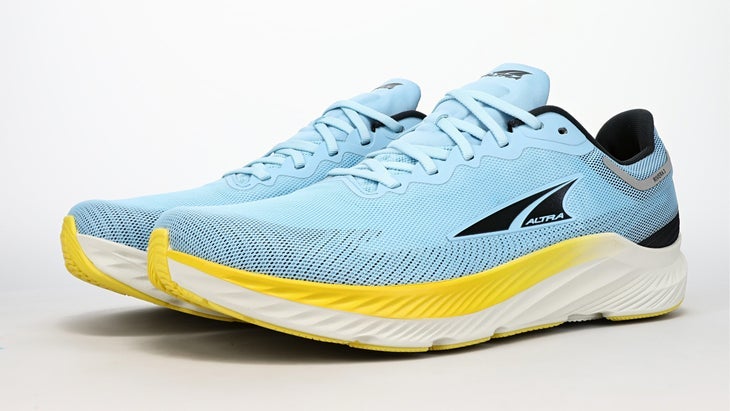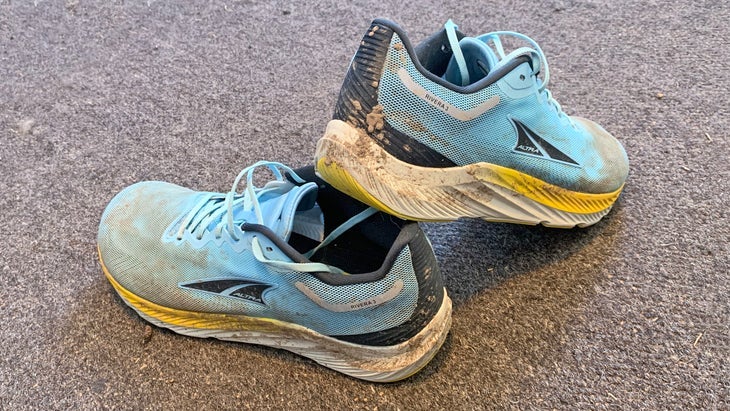New perk! Get after it with local recommendations just for you. Discover nearby events, routes out your door, and hidden gems when you sign up for the Local Running Drop.
I’ve known Altra co-founders Brian Beckstead and Golden Harper since they launched the brand a decade ago. Through the years they have never missed a chance to gently correct me whenever I said that their shoes were wide. “They’re not wide,” the founders insisted, “They’re foot shaped.” Despite their assertions, however, there was no denying that the forefoot in the original Altras was so ample that many runners’ feet swam clumsily around in the ocean surrounding the toes.
I’ve been a fan of Altras from the beginning, and a firm believer in their wide (there I go again) toebox. My research on running stride has led me to believe this shape is more important than the brand’s zero-drop platform, allowing the foot to act naturally and encouraging a balanced, stable, efficient gait. That said, I have often wished for a little less room as my feet slipped around in some of their shoes, even with the lace eyelets threatening to meet in the middle.
In February 2021, the brand released the Rivera, their first training shoe touted as having a slim fit (a few previous racing shoes had a lower-volume shape, and some trainers had a slightly svelter “standard” last). Beckstead says the new shape was designed to accommodate someone who says, “Altra is too roomy, too sloppy, my foot slips around,” or who is simply accustomed to the closer, more secure feel of narrow-toed shoes. The first version delighted narrow-footed runners, while alienating those who appreciated the generous volume Altra is known for. The second version’s upper was slightly more structured, with stitched reinforcements along the sides and less room over the toes, making it feel even more constraining.
The Rivera 3 retains the same slim shape, but Altra has refined the fit such that it feels just about perfect on my medium-width foot. Key to that fit is that while the overall volume is lower, the slimmer version is still “foot-shaped.” The shoe widens at the ball and stays wide, letting my toes splay, stabilize, and propel, rather than unnaturally binding them into a point. While this was true of earlier Riveras, the new version makes the combination of secure fit and forefoot freedom shine. As Beckstead points out, “the last is only the starting point—materials and constructions also influence fit.”

RELATED: Ask A Gear Guru: What’s In Your Shoe Quiver?
Section dividerAltra Rivera 3 Review: The Basics
The Rivera 3’s upper is a simple, flexible, highly-breathable mesh with a higher, rounder toe bumper that expands the forefoot volume. The strategically padded heel collar locks down the rearfoot, and the tongue is thinner, enhancing the hold around the instep. On the run, the upper surrounds and follows the shape of my foot, holding it securely without squeezing anywhere or realigning where it wants to move. It delivers on the Rivera’s promise of being a shoe someone new to Altra could wear and get the benefits of the shape without feeling alienated by the fit.
But Altra did more to make this third Rivera a more mainstream, transition shoe. Underfoot, they added two more millimeters of bouncy foam to the midsole, bringing it from 26 to 28 millimeters thick, and slightly softened the compound. They also made subtle changes in the pattern of the rubber pads and flex grooves on the sole, widened the base under the midfoot, and bolstered the contoured guide rails around the arch. In all, the changes transformed the ride from what was a light, close-to-the-ground shoe to that of a cushioned daily trainer that still retains the flexibility and nimbleness of a more minimalist model.
Section dividerAltra Rivera 3 Review: The Good
After several weeks of running in the Rivera, I’ve enjoyed the ride on runs at every pace and surface, ranging from treadmill intervals to easy four-milers in slushy mud. Everything falls right for me in this shoe: I touch down softly, where my foot expects to land. I roll smoothly onto the platform and transition quickly to the forefoot. The sole flexes where my foot wants to flex and lets me roll naturally off the toe. The platform is wide enough to feel supportive under heel, arch, and toes—particularly under the big toe—but not so wide it torques and twists my foot or feels clumsy. The flexible sole moves so well with my foot it feels almost like my natural padding grew an inch thicker.

Altra’s proprietary, rubbery-feeling AltraEGO foam seems to have found its sweet spot at the Rivera’s height and density, delivering soft landings balanced with a supportive and propulsive rebound. I noted and appreciated the additional thickness most in the forefoot, where it felt like the foam comfortably caught me as my weight transitioned onto the ball of my foot, then provided a welcoming stable ground for rolling onto the toes and pushing off. The Rivera’s combination of cushioned support, foot-shaped platform, and foot-following security enabled me to relax and let my foot land and move how it wanted, without fear or discomfort.
Section dividerAltra Rivera 3 Review: The Just OK
As much as I like the Rivera 3, I do have some complaints. One of the things I liked about the original Rivera was that the row of lacing eyelets ended earlier than on most shoes. The new Rivera’s eyelets extend farther down the foot—no doubt to improve the hold for those who appreciate the narrower shape—but a drawback for runners like me with disproportionately long toes, which puts my ball-of-the-foot flex point farther back. It’s easily solved by relacing the shoe with the lowest eyelets skipped, which looks a bit funny, but sets my forefoot free to splay and flex no matter how tight I cinch down the laces.
My second beef was also with the lacing system, namely that the flat laces came untied far too easily. They stayed put when double knotted, but it seems like in 2023, designers could come up with laces that tie easily with one knot and stay tied.
My final criticism is linked to a complement: On the positive side, when I’m wearing the Riveras, I feel like I run better—taller, more balanced, with a quicker cadence. When I’m maintaining good posture, the shoes don’t feel zero-drop, as my weight stays over my mid- to forefoot which compresses and creates a functional heel-to-toe drop. The flip side is that when I start to slump, and fall into taking longer, slower strides with a heavier heel strike, the shoes lose some of their magic and can feel a bit clunky. My heel sinks in, and it feels like it takes more effort to roll over the forefoot. The Rivera is far more forgiving of sloppy strides than the brand’s more minimalist Escalante, but when I’m feeling fatigued toward the end of a long run, I’ve occasionally wished for my shoes to do a little more of the work.
That said, after any run in the Rivera 3, even those where my posture flags, I return home and my legs feel surprisingly fresh. But note, while the fit and cushioning make the Rivera an easier transition to Altra’s unique feel and ride, you’re likely to still need some transition time before wearing them every day, and will enjoy them most on runs where you’re feeling fleet and light-footed.
Section dividerAltra Rivera 3 Review: Conclusions
This shoe is for you if you like the feel of toe freedom but have found Altra’s fit too wide, and you want the flexible, balanced ride of a minimalist shoe with a moderate level of soft and bouncy cushioning. The fit and ride made the Rivera 3 feel like an extension of my foot, surprising me every run with their balance of security, freedom, cushioning, and support.
This review originally appeared on Outside Online.